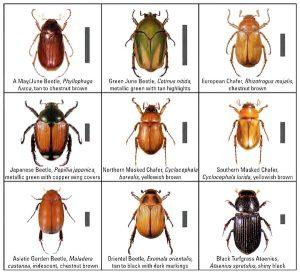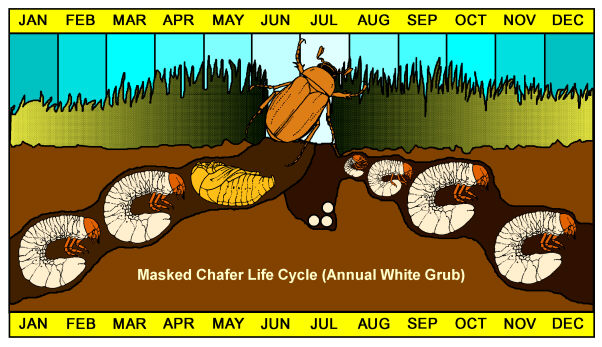In the Northeast, beetles are actively flying and laying eggs throughout July and into August. These beetles are the precursors to grubs, which can wreak havoc on lawns — especially when combined with drought stress.
Common Beetles to Watch For
Here are the most prevalent and concerning beetle species in our region:
- European Chafer: A major pest in New Hampshire and eastern Massachusetts. These beetles fly at night, so you may not see them easily.
- Japanese Beetle: While numbers appear to be decreasing, they remain widespread throughout New England and are still a top concern.
- Asiatic Garden Beetle: Found throughout southern New England, particularly in garden beds and lawns.
- Oriental Beetle: Especially common in coastal areas, often active in the evenings.

How to Scout for White Grubs
Late August through mid-September is the best time to scout for white grubs. Note: dry weather can delay egg-laying, so adjust your timing accordingly.

Grub Scouting Steps:
- Cut a three-sided square in your turf, approximately 1 square foot in size.
- Fold back the turf to expose the root zone.
- Examine the top 3–4 inches of soil.
- Count the white grubs you find.
- If more than 7–8 grubs per square foot are present, it’s time to treat.
💡 Tip: Perform this check in 3–4 different sunny areas of the lawn, where beetles tend to lay the most eggs.
Grub Treatment Options for Organic Lawns
Cultural Control Practices
- Remove Attractor Plants: Such as roses, Japanese maples, grapes, zinnias, and mountain ash—favorites for adult beetles.
- Enhance Soil Biology: Promote a healthy soil food web to support natural predators like ants, springtails, earthworms, and beneficial microbes.
- Mow High: Keeping your grass taller encourages a deeper, stronger root system, which helps resist grub damage.
Organic Product Options
- Cedar Cure* (Cedar Oil): Effective as a curative solution when applied as a soil drench or spray. Use a backpack sprayer for spot treatments or tank sprayer for larger areas. Grubs exposure to the cedarwood oil triggers the erosion of the exoskeleton. CedarCure is a minimum risk pesticide compliant with EPA 25b – making it exempt from registration by the US EPA.*
- grubGONE!: Can be applied using a standard spreader as a preventive or a curative option. The active ingredient is Bacillus thuringiensis subspecies galleriae (Btg) that once ingested will kill the grub. While grubGONE is an all-natural biological control, it is registered with the EPA and requires a pesticide license.
- hb Nematodes: A curative solution, however, require moist conditions to be effective and have a limited shelf life. Apply using a backpack sprayer in wet conditions and keep soil moist after application. Dry weather and watering restrictions have made nematodes less viable in recent years. Beneficial nematodes enter the grubs and consume them from the inside out. Nematodes are a 25b exempt product.*
*check with your state pesticide regulatory agency to see if a pesticide license is required to apply 25b products – this varies from state to state.
Final Thoughts
If you’re maintaining an organic lawn, staying proactive with beetle and grub management is essential. Monitor beetle activity now, scout for grubs in late summer, and apply treatments early to prevent damage.
Contact us if you need help choosing the best organic solution for your property!
